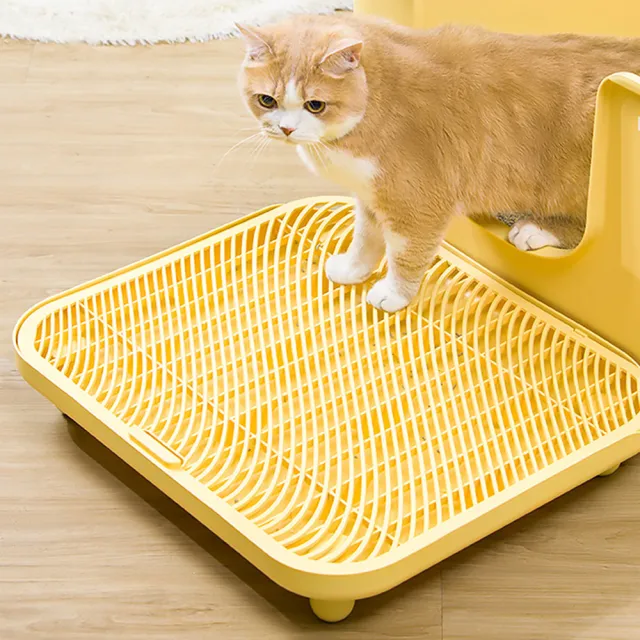Introduction:
As a cat owner, one of the most frustrating issues you might encounter is when your cat refuses to use their litter box. Litter box problems can lead to stress for both you and your feline friend, and often signal an underlying issue that needs attention. Whether your cat is not using the litter box at all or just having occasional accidents, it’s essential to understand why this is happening and how to address it.
In this article, we’ll explore the potential reasons why your cat might refuse to use the litter box and provide step-by-step instructions on how to train your cat to use it properly.
1. Understanding Why Your Cat Won’t Use the Litter Box
Before jumping into solutions, it’s important to understand that a cat’s refusal to use the litter box can be due to several reasons. These reasons can range from medical issues to behavioral problems. Here are some common reasons why your cat might not be using their litter box:
a. Medical Problems
Health issues are one of the most common causes of litter box avoidance. Cats may associate pain or discomfort with using the litter box if they have conditions such as:
- Urinary Tract Infections (UTI): UTIs can cause cats to urinate more frequently or in places outside the litter box. They might also show signs of pain when urinating.
- Bladder Stones: Similar to UTIs, bladder stones can make urination painful or difficult for your cat.
- Arthritis or Mobility Issues: Older cats or those with joint problems might find it painful to enter or exit a litter box, especially if it has high sides or is located in an inconvenient spot.
- Constipation or Diarrhea: Digestive issues can cause discomfort while using the litter box, prompting your cat to avoid it.
If your cat’s litter box avoidance seems sudden or if they display signs of discomfort, such as crying or straining, it’s crucial to consult your veterinarian to rule out any medical conditions.
b. Litter Box Cleanliness
Cats are very particular about cleanliness, and a dirty litter box can be a major turn-off. If the box is not cleaned regularly, your cat might avoid it. The smell of urine and feces can be overwhelming to your cat’s sensitive nose, leading them to seek alternative spots.
c. Litter Preferences
Not all cats like the same type of litter. Your cat might prefer one kind over another, or they might find certain types of litter too harsh on their paws. If you recently changed the type of litter, this could be the reason why your cat refuses to use the box.
d. Litter Box Location
The location of the litter box is another critical factor. Cats may refuse to use a litter box if it is in a noisy or high-traffic area. They may also avoid it if it is too close to their food or water bowls. Cats prefer a quiet, private spot to do their business.
e. Stress or Anxiety
Cats are creatures of habit and can become stressed or anxious due to changes in their environment. This could include moving to a new home, a new pet or person in the house, or changes to their daily routine. Stress can lead to behavior changes, including avoiding the litter box.
f. Litter Box Size or Type
A litter box that is too small or has high sides might make it difficult for your cat to enter or turn around inside. Cats that are larger or older may find such boxes uncomfortable. Similarly, a box with a cover may trap odors inside, making the experience unpleasant for your cat.
2. How to Train Your Cat to Use the Litter Box
Once you’ve identified the potential reasons for your cat’s litter box avoidance, the next step is to take action. Training your cat to use the litter box is possible with patience and consistency. Here are some practical steps to help you:
a. Ensure the Litter Box is Clean
Cats are fastidious creatures, and they won’t use a dirty litter box. Make sure to clean the box at least once a day by scooping out waste and replacing the litter regularly. Additionally, thoroughly wash the box with mild soap and water every few weeks to keep it free of odors.
b. Choose the Right Litter Box and Litter
Selecting the right litter box and litter is crucial for your cat’s comfort. Consider the following:
- Size: Choose a litter box that is large enough for your cat to move around comfortably. If your cat is older or has mobility issues, you might want a low-sided box for easy entry and exit.
- Litter: Experiment with different types of litter to find the one your cat prefers. Some cats like clumping litter, while others prefer non-clumping varieties. Unscented litters are generally the best option since some cats are sensitive to strong fragrances.
- Litter Box Type: If your cat is avoiding a covered litter box, try using an uncovered one instead. Some cats feel claustrophobic in covered boxes or may not like the trapped odors.
c. Place the Litter Box in a Quiet, Accessible Location
Cats prefer privacy when using the litter box, so place it in a quiet, low-traffic area where your cat feels safe. Avoid putting the box near their food or water bowls, as cats generally prefer separation between eating and eliminating. Ensure that the box is easily accessible and not too high or low for your cat to reach.
d. Gradually Encourage Your Cat to Use the Litter Box
If your cat is avoiding the litter box, try to gently encourage them to use it. Here’s how:
- Create Positive Associations: Whenever your cat shows interest in the litter box or enters it, reward them with praise or a treat. Positive reinforcement will help your cat associate the litter box with something pleasant.
- Use a Consistent Routine: Place your cat in the litter box after meals, naps, or playtime—when they’re most likely to need to use the bathroom. Cats usually need to eliminate shortly after eating or drinking.
- Limit Access to Other Areas: If your cat is consistently avoiding the litter box, confine them to a smaller area with the box. This can help them get used to using the box more regularly, especially if they have been going outside of it.
e. Address Stress and Anxiety
If your cat’s refusal to use the litter box is related to stress or anxiety, try to identify and address the underlying cause. Provide your cat with a calm and secure environment, and try to reduce any sources of stress in their life. This could include creating a more predictable routine, providing hiding spots for them to retreat to, or using calming products such as pheromone diffusers.
f. Consider Multiple Litter Boxes
In multi-cat households, it’s recommended to have one litter box per cat, plus one extra. This ensures that there’s always a clean and available litter box, preventing territorial issues and reducing the likelihood of accidents.

3. When to See a Veterinarian
If your cat continues to avoid the litter box despite your best efforts, it may be time to consult a veterinarian. Medical conditions such as urinary tract infections, bladder stones, or arthritis can cause litter box avoidance and should be ruled out.
A veterinarian can perform a thorough examination and may recommend further testing or treatments based on your cat’s symptoms.
4. Conclusion
Litter box issues are frustrating, but with patience, understanding, and the right approach, you can help your cat learn to use the litter box consistently. Start by identifying any potential medical or environmental causes, and then implement practical training strategies. Ensure the litter box is clean, appropriately located, and tailored to your cat’s preferences.
With time and positive reinforcement, your cat will likely return to using the litter box as they should. If the problem persists, don’t hesitate to reach out to your veterinarian for further guidance.























































